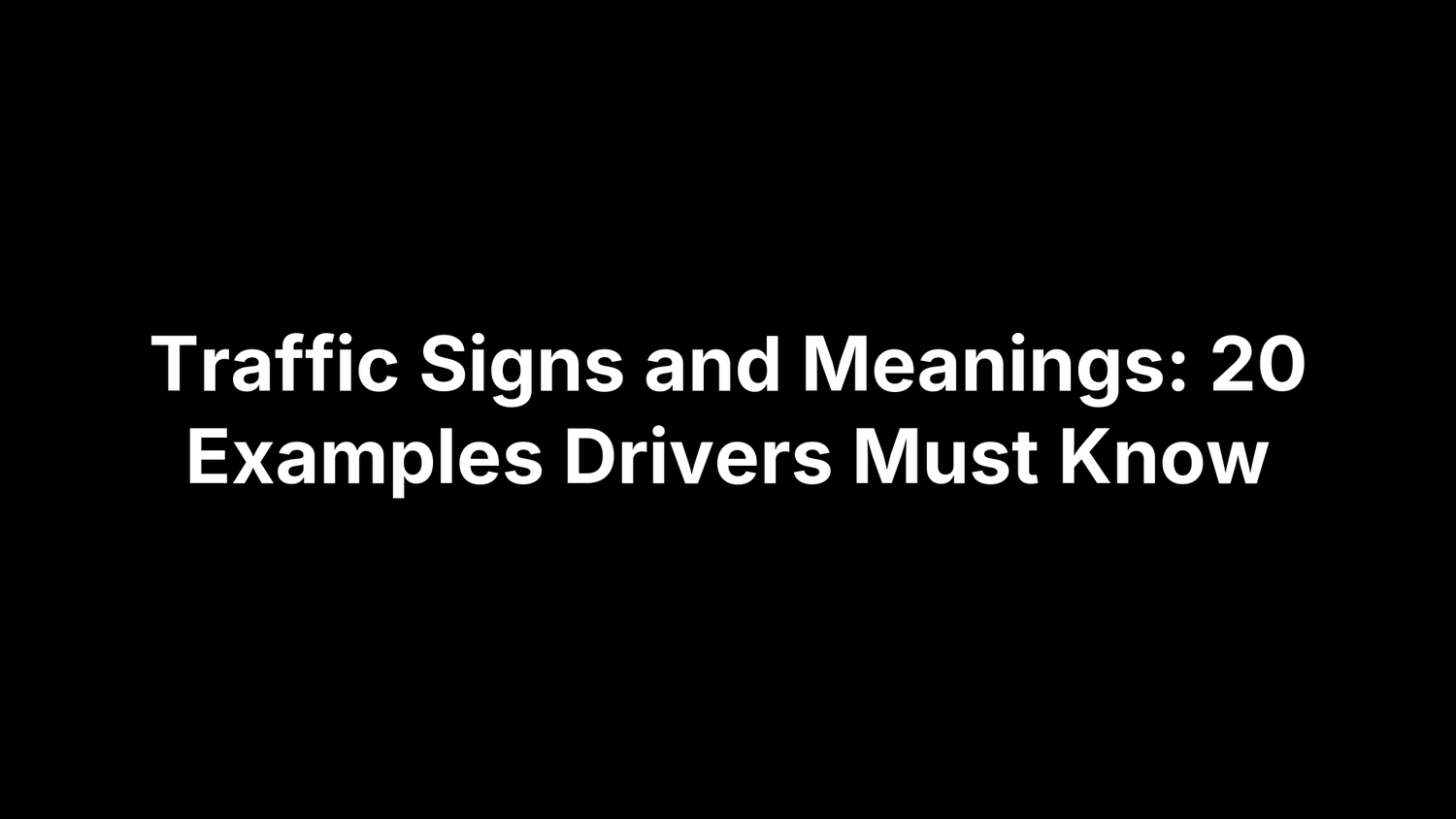Traffic Signs and Meanings: 20 Examples Drivers Must Know
Missing a sign by a split-second can mean a ticket, a tow, or a trip to the ER. Whether you’re cramming for the permit test or just want to drive with more confidence, mastering the language of traffic signs is the fastest skill upgrade you can give yourself. These aluminum sheets of color and shape are more than roadside décor—they’re legally binding instructions engineered to be understood at 70 mph, at night, and in sideways rain.
Before we jump into 20 signs you need to know, let’s establish a pocket key. Red forbids, yellow warns, orange marks work zones, green guides, blue shows services. Shapes confirm the message when color fades—octagon = STOP, triangle yields, diamond warns, rectangle regulates or directs. Mastering this code can slash questions from your DMV exam and precious seconds from reaction time when danger flashes ahead. Next, we’ll break down 20 examples, grouped by their official categories, complete with visuals, legal meanings, and test-friendly memory tricks.
1. Stop Sign (Regulatory)
The red octagon is America’s universal command to hit the brakes—ignore it at your peril.
Appearance & Shape
Red octagon, white “STOP” lettering; the only eight-sided sign on U.S. roads.
Official Meaning & Legal Weight
Law requires a full stop at the stop line or crosswalk; first-come, first-go at four-way intersections. Violations can cost up to $200 and add three points to your license.
Correct Driver Response
Brake smoothly, halt, hold three seconds, scan left-right-left, then proceed only when clear.
Memory Trick
Eight sides = stop from every side.
2. Yield Sign (Regulatory)
Posted at roundabouts and merge ramps, the Yield sign politely tells you to give others priority—or face citations.
Appearance & Shape
White downward triangle, thick red border, red “YIELD” letters.
Meaning & Right-of-Way Rule
Legally slow or stop until cross-traffic and pedestrians can proceed safely.
Driver Best Practice
Cover the brake, scan left and right, enter gap smoothly; never force a merge.
Memory Trick
Triangle points down at the pavement you’re surrendering.
3. Speed Limit Sign (Regulatory)
This is the most common regulatory marker on U.S. roads, telling you the fastest you may legally drive under ideal conditions. Blow past it and you invite tickets, license points, and a premium hike your wallet will remember.
Standard & Variable Looks
- Classic style: vertical white rectangle with bold black numerals (e.g., “45”).
- Variations: added legends like “MINIMUM,” “NIGHT,” or dual “TRUCK” speeds; work-zone orange overlays; freeway “Variable Speed Limit” panels that switch digits electronically.
Meaning & Enforcement
The posted number is the maximum lawful speed when weather, traffic, and visibility are good. Under the Basic Speed Law you must slow further for rain, ice, fog, or congestion—even if that means 20 mph below the sign.
Driver Action Plan
Glance at the sign, match your speedometer, and watch for doubled-fine or photo-enforcement zones. If limits drop ahead, ease off early instead of hard-braking at the last second.
Memory Trick
“Black on white is the law in black and white.”
4. Do Not Enter Sign (Regulatory)
Ignore this sign and you could be staring at headlights coming straight for you.
Appearance
Red circle containing a white horizontal bar—no words needed because the design screams “wrong way.”
Meaning
Indicates that entry is prohibited; typically guards freeway off-ramps, one-way streets, and restricted areas.
Safe Response
Stop, signal, and turn around at the first safe gap.
Memory Trick
Picture the white bar as a barricade blocking your lane.
5. One Way Sign (Regulatory)
Miss it and you might steer straight into oncoming traffic.
Appearance
Horizontal white rectangle showing a black arrow and the words “ONE WAY.”
Meaning
Traffic may move only in the arrow’s direction; entering opposite is illegal.
Driver Response
Stay in that lane, follow pavement arrows, and watch for wrong-way drivers.
Memory Trick
One bold arrow, one legal path.
6. No U-Turn Sign (Regulatory)
Missed a turn? This sign kills the quick 180.
Appearance
Black curved U-arrow on white, wrapped in a red circle with a diagonal slash.
Meaning
Officially bans any U-turn at that spot and usually for the next intersection.
Driver Response
Roll on straight, find a legal turnaround ahead, and avoid the citation plus license points.
Memory Trick
U-turn crossed out means option crossed off.
7. Railroad Crossing Sign (Advance Warning)
Appearance
Circular yellow sign with black X and “RR”; trackside white crossbuck says RAILROAD CROSSING.
Meaning
Alerts drivers to a rail crossing; crossbuck equals Yield—trains always have priority.
Driver Procedure
Slow, look, listen. Stop 15 ft back if lights flash or gate lowers, and wait until you can clear completely. Never stop or shift while on the tracks.
Memory Trick
X marks the tracks—treat rails like a train’s right-of-way only.
8. School Zone Ahead Sign (School Warning)
Children are unpredictable, and this sign exists to buy you extra reaction time. Spot it early and you’ll avoid both heartbreak and a hefty ticket.
Appearance
Fluorescent yellow-green pentagon featuring two walking figures.
Meaning
Signals an upcoming school zone with legally reduced speed and heavy child pedestrian activity.
Driver Action
Brake to the posted school speed, obey crossing guards, ban passing or U-turns, eyes on sidewalks.
Memory Trick
House-shaped sign resembles a schoolhouse—slow like you’re driving through the hallway.
9. Pedestrian Crossing Sign (Warning)
When you spot this yellow diamond, assume someone on foot could enter your lane at any second—often mid-block.
Appearance
Yellow or fluorescent yellow-green diamond or rectangle with a stylized walker icon.
Meaning
Indicates a legal pedestrian crossing where drivers must yield.
Driver Action
Cover brake, creep, never pass a car stopped in the crosswalk.
Memory Trick
Stick-man means stick to yielding.
10. Merge Sign (Warning)
The Merge sign gives advance notice that lane real estate is about to shrink—use the heads-up to blend, not bully.
Appearance
Yellow diamond with a black through-arrow sprouting a short side branch.
Meaning
Warns that two lanes will taper into one; drivers in the ending lane must yield.
Driver Action
Signal early, pace traffic, maintain a gap, and zipper-merge one-for-one.
Memory Trick
Arrow grows a tail—two become one.
11. Lane Ends Sign (Warning)
This yellow diamond is the heads-up that your lane is about to disappear.
Appearance
Yellow diamond, two parallel lines with one tapering inward.
Meaning
Warns that the pictured lane will end, requiring a merge.
Driver Action
Signal, check mirrors, zipper-merge—skip last-second swerves.
Memory Trick
Missing line = missing lane.
12. Divided Highway Begins Sign (Warning)
Appearance
Yellow diamond with arrow that splits around a central median.
Meaning
Marks start of divided highway; traffic separated, keep right of island.
Driver Action
Stay in right roadway, cancel passing plans, and prepare for higher speeds.
Memory Trick
Split arrow = split lanes.
13. Divided Highway Ends Sign (Warning)
This warning sign signals the moment the protective median ahead disappears.
Appearance
Yellow diamond with two opposing arrows converging above a tiny median block.
Meaning
Indicates divided highway ends; expect opposing traffic in adjacent lane.
Driver Action
Slow slightly, stay right of centerline, and skip passing until roadway widens again.
Memory Trick
Arrows meet—so do you and traffic.
14. Slippery When Wet Sign (Warning)
Appearance
Yellow diamond with a black symbol of a car leaving curvy skid marks.
Meaning
Pavement ahead turns slick when rain, ice, oil, or fallen leaves appear, slashing available traction.
Driver Action
Lift off the gas before the hazard, steer and brake gently, widen following distance, and drop to a lower gear on downhill stretches.
Memory Trick
The wiggly tire tracks warn your ride will wiggle too—feather those pedals.
15. Construction Ahead Sign (Work-Zone Warning)
15. Construction Ahead Sign (Work-Zone Warning)
Appearance
Bright-orange diamond with either a silhouette of a man holding a shovel or the words “ROAD WORK AHEAD” in bold black letters. High-intensity retro-reflective sheeting makes it pop at night.
Meaning
Marks the beginning of an active construction zone where lane shifts, rough pavement, and workers on foot are likely. By state law, tickets here can come with doubled fines and license points.
Driver Action
Ease off the throttle to the temporary speed limit before you reach the first cone. Keep a full car-length gap, follow barrel lines, and do exactly what any flagger signals—treat them like portable stoplights.
Memory Trick
Orange is the color of safety vests, so orange diamonds mean people, not just pavement, are in harm’s way.
16. Detour Sign (Work-Zone Guide)
Appearance
Horizontal orange rectangle stamped with bold black “DETOUR” and a thick one-way arrow; extra arrow panels may appear farther along.
Meaning
Marks the official alternate route around a closure, crash, or construction project.
Driver Action
Trust the first sign, then follow every subsequent arrow—think of them as low-tech GPS. Expect lower limits, flaggers, and sketchy pavement.
Memory Trick
Orange arrow = temporary roadmap; follow the color and you’ll never be lost.
17. Exit-Only Lane Sign (Guide)
Yellow-bottomed guide signs warn that a specific freeway lane is exit-only.
Appearance
Green overhead sign sporting a bright yellow “EXIT ONLY” panel beneath the destination arrow.
Meaning
That lane must leave the highway at the next interchange; staying straight is illegal.
Driver Action
If you intend to continue, signal and merge left before the solid gore lines begin; otherwise commit and bleed off speed to match the ramp.
Memory Trick
Yellow tells you you’ll mellow into an exit.
18. Interstate Route Marker (Guide)
Appearance
Red-white-blue shield with big white numerals, spaced along the roadway.
Meaning
Marks a highway in the Interstate System. Odd numbers indicate north–south, even east–west. Three-digit shields: first digit even = loop, odd = spur route.
Driver Action
Match the shield’s number with boards and mile markers, verify GPS instructions, and quote it when calling 911 for help.
Memory Trick
Patriotic shield = nation’s high-speed backbone road.
19. Hospital Service Sign (Service Guide)
19. Hospital Service Sign (Service Guide)
Appearance
Blue square or rectangle with a white “H” in the center, coated with retro-reflective sheeting for night guidance.
Meaning
Signals that a hospital or 24-hour emergency medical facility is close; steers motorists and EMS toward urgent care.
Driver Action
Note the exit number or cross street for future reference, yield to ambulances, and keep driveways and fire lanes clear.
Memory Trick
H stands for “Help” and “Health”—blue matches first-aid crews.
20. Mile Marker Sign (Guide)
Appearance
Slim green post or rectangular sign bearing a white mile number, usually every mile.
Meaning
Indicates exactly how many miles you are from the state line; critical for navigation and emergency dispatch.
Driver Action
Give the nearest marker to 911 or roadside aid; use them to pace fuel stops and arrival time.
Memory Trick
Green equals “go” count miles like a roadside odometer.
Key Takeaways for Safer Driving
Being able to read a sign’s color and shape before you even see the lettering slashes reaction time. Red stops or forbids, yellow warns, fluorescent yellow-green spotlights people, orange marks work zones, while green and blue simply guide or serve. Lock that code in your muscle memory and every new sign becomes instantly familiar.
- Recognize the four master categories—Regulatory, Warning, Work-Zone, Guide/Service—and you’ll ace 90 % of permit questions.
- Always match your driving to the strictest sign in view; the law rewards caution, not speed.
- Pair sign clues with conditions: the Basic Speed Law still rules when rain, fog, or ice appear.
- Read guide signs early so you can slide over calmly instead of panic-cutting across lanes.
- Quote mile markers and exit numbers when calling 911; it trims precious minutes off emergency response.
Ready to back up this knowledge with crystal-clear labels for your worksite or fleet? Explore custom, MUTCD-friendly options at Safety Decals and drive safety home.


